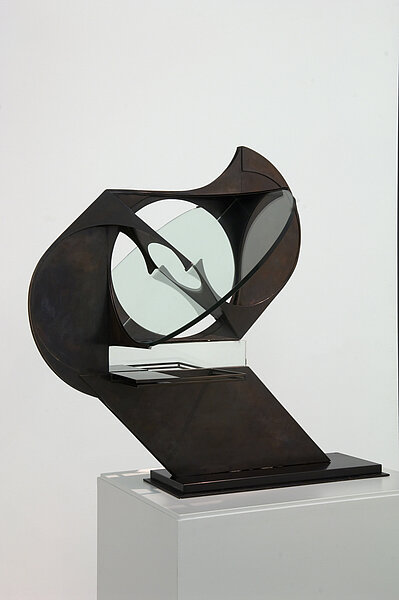
Pevsner, Antoine
Konstruktion für einen Flughafen
Construction Design for an Airport
1934 - 1935
| Object description | Bronze, glass |
|---|---|
| Object category | plastic |
| Material | |
| Technique |
object:
construction
|
| Dimensions |
weight:
weight: 50 kg
Pedestal measure:
height: 22 cm,
width: 57 cm
Objektmaß:
height: 80,5 cm,
width: 81 cm,
depth: 85 cm
|
| Year of acquisition | 1959 |
| Inventory number | P 1/0 |
| Creditline | mumok - Museum moderner Kunst Stiftung Ludwig Wien |
| Rights reference | Bildrecht, Wien |
| Further information about the person | Pevsner, Antoine [GND] |
| Literature |
Genau und anders :Mathematik in der Kunst von Dürer bis Sol LeWitt Laboratorium Moderne/Bildende Kunst, Fotografie und Film im Aufbruch |
Antoine Pevsner and his brother Naum Gabo are regarded as the founders of constructivist sculpture. In 1917, at the time of the October Revolution, Pevsner was teaching at the Moscow Academy, as were Malevich, Kandinsky and Tatlin. In 1920, together with Naum Gabo he published the “Realistic Manifesto”, a theory of Constructivism. Contrary to Tatlin he now redefines Constructivism as a modernist style without any claims to be revolutionary. Kinetics provided the basis for the new art. Pevsner stated in his manifesto: “We reject volume as a form of painterly and plastic space. Thus we take four bottles and build the same volume out of them as a four ton mass. In that way we give the line, as a directional sign, back to sculpture”. In 1921 Pevsner was prohibited from teaching and emigrated to France. In Paris he continued to work on the question as to how the fourth dimension can be incorporated into a three-dimensional work, i.e. time or movement through time and space. Pevsner tried to produce movement as an optical event in a static body. In his hollow sculptures volume is no longer formed by a static mass as is traditional. It is, rather, that a construction of sheet materials and wires outline a volume. In this way real space and light are included in the sculpture. On the other hand, as one walks round the sculpture, the convex and concave surfaces and lines seem to make the delineated volume vibrate.
© mumok – museum moderner kunst stiftung ludwig wien

